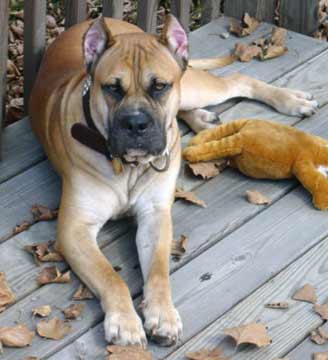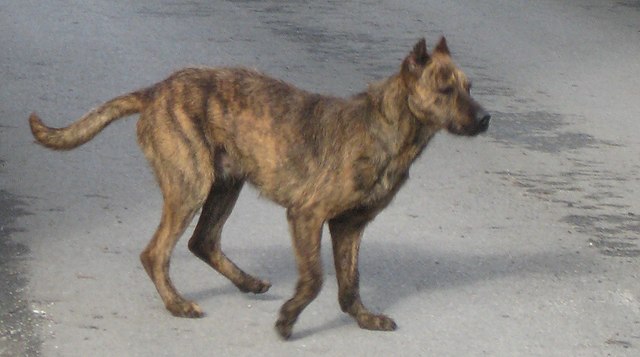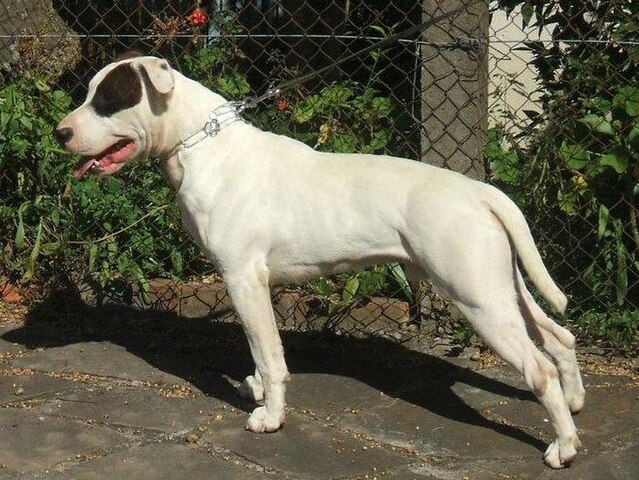The Tosa is a courageous mastiff-type breed originally bred in Japan as a fighting dog. In fact, members of the breed were treated with great honor during and after a fight, even being outfitted with ceremonial sashes. Nowadays they are used primarily as watch and guard dogs. And they get the job done… these guys can pack a punch as they weigh anywhere from 100 to 200 pounds! Individuals may take up to 4 years in order to become fully mature and reach these heights, although it should be noted that dogs in Japan are often a little smaller.
Tosas are obedient when trained – a good thing, because such a large breed definitely needs early (and continued) obedience training. Without it, they can easily overpower most humans! Seeing as how they are already on “restricted breed lists” in many places, it is vital that those who own them make sure they are good citizens both inside and outside the home. They do best with plenty of positive reinforcement but firm, fair corrections have their place when done correctly. These intelligent, yet dominant dogs do want to please their owners, however they have several quirks that make them ill-suited to being trained by a novice.
The Tosa shouldn’t be ferocious unless he absolutely needs to be. In the home he is calm, quiet and composed. He is always watching vigilantly to make sure his people and property are protected, but he won’t make a huge display unless it is warranted. If it is warranted… he can do a lot of damage. This is a breed that will show loyal affection to his master in an unassuming way, and will treat strangers with aloofness. Outright aggression for no reason is not typical of the breed but it is vital that he be well-bred and given regular training and socialization to make sure this holds true. A poorly bred or untrained Tosa in the wrong hands can be unpredictable and quickly become a liability.
Tosas are easy to groom and are considered a low-shedding breed. Despite this perk, for the many reasons listed above this is still not a breed for a novice dog owner! Their fearless nature and natural protective instinct, combined with their easy grooming, may make them sound perfect to some people but there must be plenty of knowledge, skill and time put into these dogs.
Because of their fighting lineage, the Tosa doesn’t always get along with other dogs, especially if it’s a strange dog coming onto their property (or a dog of the same sex). Many people have a hard time living with multiple dogs when they own this breed. Owners must make sure that their Tosa never gets out to roam – a territorial breed like this one could prove dangerous to other dogs, cats and animals. The breed can even be iffy around livestock. Not every dog works for every person’s situation, and this is a breed that is not adaptable to just any living situation! Another scenario that is less-than-desirable… for many reasons, the Tosa does not work well in an apartment.
Although the Tosa is a low-energy breed, he still needs some exercise. Walks around the neighborhood are great, as well as having access to a fully fenced yard. Electronic fences are not a good idea for this breed. Although they are low energy, they still have a ton of athleticism and are capable of jumping a short fence, or running right through an electronic one with little issue. Seeing a cat running on the other side of the property, for example, is enough of an incentive for most to leap right out of the yard.
Tosas can get along well with children although it is important that he is raised with them from puppy-hood. Furthermore, supervision is 100% necessary whenever the kids and dog are playing together – small kids with flighty movements may invoke his fighting instincts. Furthermore, his sheer bulk makes it easy for him to knock over or accidentally hurt a very small child. Assess the situation carefully before bringing this breed home.




